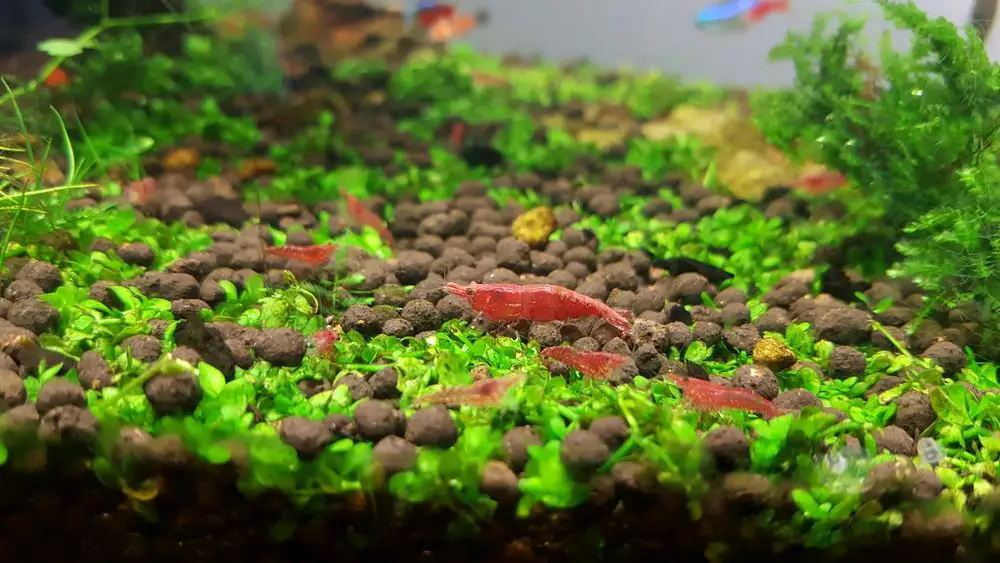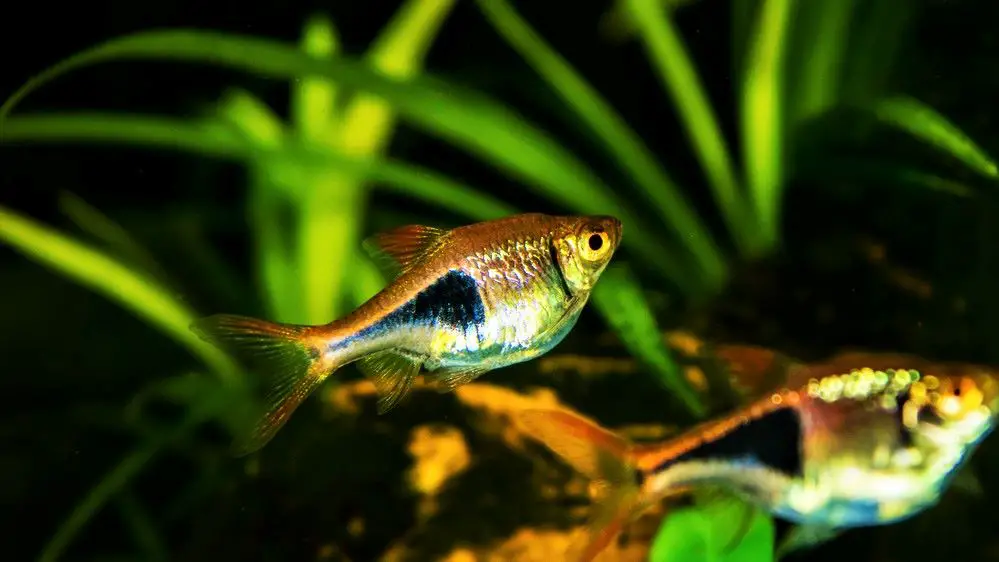Found yourself mesmerized by the vibrant colors of Harlequin Rasbora and thought about adding them to your shrimp tank? Or maybe you’re just looking for a way to add some diversity to your aquatic ecosystem. But wait, will these colorful fish get along with your Red Cherry Shrimp, or will they turn your peaceful tank into a battlefield?
While it’s technically possible to keep Harlequin Rasbora with Red Cherry Shrimp, it’s generally not recommended as the Rasboras may prey on the shrimp, especially the shrimplets.
As a shrimp keeper, I’ve always been fascinated by the idea of creating a diverse, vibrant, and harmonious underwater world. But, as we all know, achieving this balance is easier said than done.
I remember first considering introducing Harlequin Rasbora into my Red Cherry Shrimp tank. The idea of having these colorful fish darting around the tank while my shrimp peacefully grazed seemed like a dream come true. But then, I noticed the Rasboras taking a little too much interest in my shrimplets.
Over the years, I’ve learned that while keeping these species together is possible, it requires careful management and constant vigilance to prevent the Rasboras from turning the shrimplets into a snack.
In this post, we’ll delve into the challenges of keeping Harlequin Rasbora with Red Cherry Shrimp, and I’ll share some of the strategies I’ve used to mitigate these issues. So, if you’re thinking about adding some Rasboras to your shrimp tank, keep reading. You’re in for an enlightening journey.

What are the behaviors of Harlequin Rasbora in a shrimp tank?
When we introduce Harlequin Rasbora into a shrimp tank, their behaviors can significantly impact the overall dynamics of the tank. Harlequin Rasboras are known for their vibrant colors and active nature, which can add a lot of life and movement to your aquarium. However, their behaviors can vary, especially when they share a tank with shrimp.
Harlequin Rasboras are generally peaceful fish that spend most of their time in the middle to upper levels of the tank. They are schooling fish, meaning they prefer to swim in groups, which can be a fascinating sight for any aquarium enthusiast.
However, they are also known to be quite active and can become more aggressive during feeding times. This could potentially pose a risk to your shrimp, especially the smaller and more vulnerable shrimplets.
It’s also important to note that Harlequin Rasboras are omnivorous. While their diet primarily consists of small invertebrates, insects, and plant matter in the wild, in a home aquarium, they can adapt to eat a variety of commercial fish foods. This means that if food becomes scarce, they might turn their attention to the shrimp in the tank.
In conclusion, while Harlequin Rasboras can coexist with shrimp in a tank, their behaviors need to be closely monitored. Providing plenty of hiding spots for the shrimp and ensuring the fish are well-fed can help maintain a peaceful coexistence.

How does the size of the fish’s mouth affect the safety of shrimp?
The size of a fish’s mouth plays a crucial role in determining the safety of shrimp in a shared aquarium. This might seem like a minor detail, but it can have significant implications for the survival of your shrimp, especially the younger and smaller ones.
Fish are opportunistic feeders, and the size of their mouths primarily dictates their feeding habits. Simply put, if a fish can fit something into its mouth, it’s likely to try and eat it. This is where the size of the fish’s mouth becomes a critical factor when keeping them with shrimp.
Shrimp, particularly the shrimplets, are small and can easily fit into the mouths of many fish species. If you have fish with large mouths in your shrimp tank, the shrimp are at a higher risk of being eaten. This is especially true during periods when the fish are hungry or when food is scarce in the tank.
On the other hand, fish with smaller mouths are less likely to pose a threat to adult shrimp simply because they can’t fit the shrimp into their mouths. However, shrimplets are still at risk even with these smaller-mouthed fish.
It’s also worth noting that the fish’s feeding behavior and aggression levels can influence the safety of shrimp. Despite having small mouths, some fish can exhibit aggressive feeding behaviors and may still attempt to go after shrimp.

What are the alternatives to Harlequin Rasbora for a shrimp tank?
When considering alternatives to Harlequin Rasbora for a shrimp tank, it’s essential to look for species that are peaceful, non-aggressive, and have a small mouth size to ensure the safety of your shrimp.
One such alternative could be the Otocinclus Catfish, often referred to as “Ottos.” These small, peaceful fish are known for their algae-eating habits and are generally considered safe tank mates for shrimp. They spend most of their time scavenging for algae on the tank’s surfaces, leaving the shrimp and their young undisturbed.
Pygmy Corydoras are another option. These tiny catfish are bottom dwellers and are known for their peaceful nature. They are primarily detritus feeders, which means they feed on the material that falls to the bottom of the tank, including leftover food, decaying plant matter, and biofilm, which makes them less likely to bother the shrimp.
Guppies can also be a good choice. They are livebearers, meaning they give birth to live young rather than laying eggs, which can provide an additional food source for your shrimp. However, it’s important to note that while adult guppies are generally safe with adult shrimp, they may pose a threat to shrimplets.
Lastly, consider small and peaceful invertebrates as alternatives. Snails, for instance, can be a great addition to a shrimp tank. They are peaceful, won’t bother your shrimp, and can help control algae and break down detritus.
Remember, while these alternatives are generally considered safe for shrimp, individual behaviors can vary, and no fish is 100% shrimp safe. Always monitor your tank closely when introducing new species to ensure the safety and well-being of your shrimp.
How does the feeding behavior of fish impact the shrimp population?

The feeding behavior of fish can significantly impact the shrimp population in an aquarium, and understanding this dynamic is crucial for maintaining a healthy and thriving shrimp community.
Fish are opportunistic feeders, meaning they’ll eat whatever is available and fits into their mouths. This behavior can pose a threat to shrimp, especially the smaller and more vulnerable shrimplets. If a fish comes across a shrimplet while searching for food, it’s likely to see it as a potential meal.
This can decrease the shrimp population over time, particularly if the fish in the tank have large mouths and aggressive feeding behaviors.
Moreover, fish and shrimp often compete for the same food sources, especially in a home aquarium where their diets overlap significantly. If the fish are faster or more aggressive feeders, they might consume most of the food before the shrimp get a chance to eat.
This competition can lead to malnutrition in shrimp, affecting their health, growth, and reproduction, which in turn can impact the overall shrimp population.
On the other hand, the feeding behavior of fish can also indirectly benefit the shrimp population in some cases. For instance, fish that feed on algae help maintain clean and healthy water conditions, which is beneficial for shrimp.
Similarly, fish that stir up the substrate in search of food can help prevent the buildup of harmful substances, promoting a healthier environment for the shrimp.
While the feeding behavior of fish can pose challenges to the shrimp population, careful selection of fish species and proper feeding strategies can help mitigate these risks and maintain a balanced and harmonious aquarium ecosystem.
How can a heavily planted tank affect the interaction between fish and shrimp?
A heavily planted tank can significantly influence the interaction between fish and shrimp, often in ways that are beneficial for the shrimp population.
One of the primary benefits of a heavily planted tank is that it provides ample hiding spots for shrimp. Shrimp, especially shrimplets, are vulnerable to predation from fish. Having a variety of plants in the tank allows the shrimp to hide and escape from potential predators, increasing their chances of survival.
Plants also contribute to the overall health of the aquarium by helping to maintain water quality. They absorb harmful substances like nitrates and phosphates, which can be detrimental to both fish and shrimp. By improving water quality, plants create a healthier environment for all inhabitants of the tank.
Moreover, plants can serve as a food source for shrimp. Shrimp often graze on the biofilm that grows on plant surfaces, which is a crucial part of their diet. In a heavily planted tank, shrimp have access to a constant supply of this nutritious food source.
However, it’s worth noting that a heavily planted tank can also have some drawbacks. Dense plant growth can limit the swimming space for fish, which might lead to increased stress and aggression. This could potentially result in more aggressive behavior towards shrimp.
Maintaining a heavily planted tank requires careful management to prevent overgrowth and ensure all plants receive adequate light and nutrients.
While a heavily planted tank can influence the interaction between fish and shrimp, careful planning and management can provide a beneficial environment supporting a thriving shrimp population.
Wrapping Up: Can I keep Harlequin Rasbora with Red Cherry Shrimp?
While it’s technically possible to keep Harlequin Rasbora and Neon Tetra with Red Cherry Shrimp, it’s not something that I would recommend. The behaviors and feeding habits of these fish, coupled with their mouth size, can threaten your shrimp, particularly the shrimplets.
However, with careful management, including providing plenty of hiding spots and ensuring the fish are well-fed, it’s possible to maintain a peaceful coexistence.
If you’re looking for alternatives, consider species like Otocinclus Catfish, Pygmy Corydoras, or even peaceful invertebrates like snails. Remember, the key is to closely monitor your tank and adjust as necessary to ensure the safety and well-being of your shrimp.
If you need any further help or have any questions, please don’t hesitate to reach out. Check out Aquarium Shrimp Keeping on Facebook if you can’t reach me here. We have a community of shrimp keepers who are always ready to help.
Finally, remember that every aquarium is unique, and what works for one might not work for another. So, keep observing, learning, and most importantly, enjoying the wonderful world of shrimp keeping.
Happy Shrimp Keeping!
Frequently Asked Questions: Can I keep Harlequin Rasbora with Red Cherry Shrimp?
Q. What are harlequin rasboras compatible with?
A. Harlequin rasboras are compatible with many species due to their peaceful nature. They can coexist with other peaceful fish, snails, and live plants. However, while they are safe with adult shrimp, they might prey on shrimp fry.
Q. What fish not to keep with cherry shrimp?
A. Any fish with a large mouth or aggressive feeding behavior can pose a threat to cherry shrimp. This includes larger or predatory fish species that can easily eat shrimp, especially the smaller and more vulnerable shrimplets.
Q. What rasbora is best for shrimp?
A. The best rasbora for a shrimp tank would be one that is peaceful and has a small mouth size. However, even the most peaceful fish can pose a risk to shrimplets, so it’s important to provide plenty of hiding spots for the shrimp.
Q. What fish can you put with cherry shrimp?
A. Several small, peaceful fish species can coexist with cherry shrimp. These include Otocinclus Catfish, Pygmy Corydoras, and Ember Tetra. However, always monitor your tank closely when introducing new species to ensure the safety of your shrimp.
Q. Will harlequin Raspboras eat shrimp?
A. Harlequin rasboras are generally peaceful and are considered one of the least shrimp aggressive fish. However, they might prey on shrimp fry, especially during feeding times or when food is scarce.
